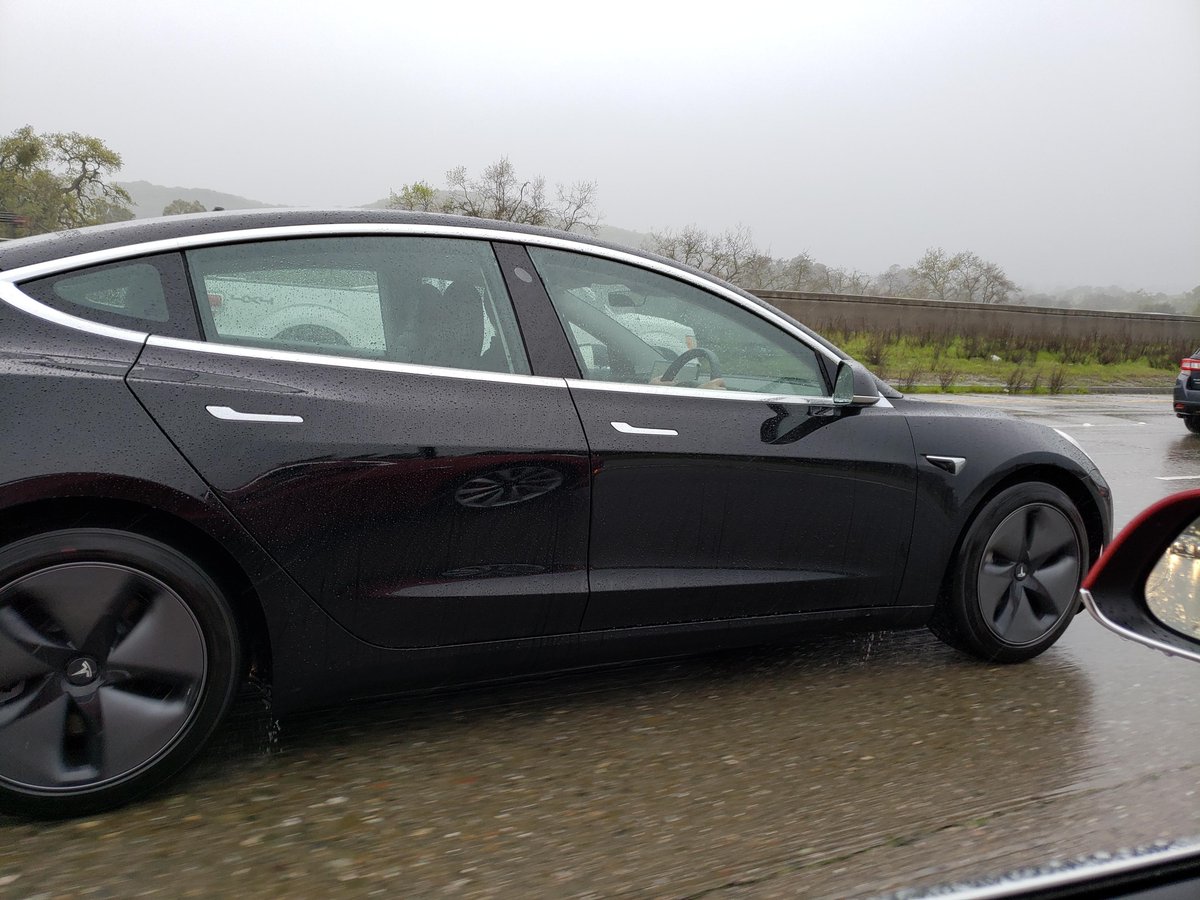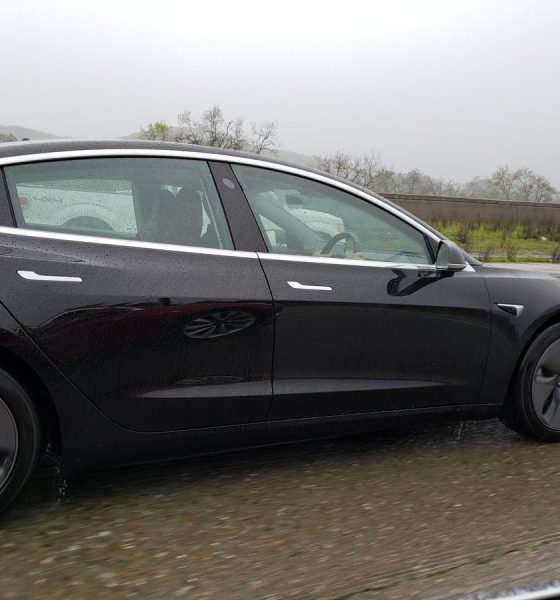

News
Tesla Model 3 right-hand-drive is coming to the UK market in May, says Elon Musk
Tesla’s Model 3 online ordering will finally be open to customers in right-hand-drive (RHD) markets between May 1st and 2nd, according to CEO Elon Musk. A mid-2019 release for the RHD variant was predicted over the last year, thus aligning well with Musk’s recent announcement.
UK order page will go live around May 1 or 2
— Elon Musk (@elonmusk) April 25, 2019
Anticipation for Model 3 in right-hand-drive markets has been building since first deliveries of the electric midsize sedan began in left-hand-drive areas of Europe in January. And Tesla’s continued sales ramp in Europe has further increased that enthusiasm. Musk acknowledged the patience exerted by Tesla’s UK buyers in an instance on Twitter last year, even suggesting a used Model S as an alternative in the meantime for future customers.
“Probably mid next year before we are able to make RHD. Wish it could be sooner. Maybe try a Model S, used or new in the meantime? Used S is better than a new 3 imo, unless you want a smaller car,” Musk replied to one inquiry.

The Model 3 design included multiple configurations from the start and, thanks to its symmetrical nature, minimal retooling and engineering were needed to begin production on the right-hand-drive version. Tesla has also heeding lessons from the production and delivery processes it underwent with the Model 3 in the US and Europe, altogether spelling out a more predictable purchasing process for its RHD market. Profitability is expected to return for the company in Q3 2019, according to Musk in the Q1 2019 earnings call, and the anticipated demand for RHD variants in green-energy-seeking markets like Australia and the UK may have been factored into Tesla’s considerations.
Model 3 was designed for min engineering & tooling change for RHD. Note left/right symmetry. LHD for Europe & Asia first half of next year. RHD probably middle of next year.
— Elon Musk (@elonmusk) May 25, 2018
Progress on the right-hand-drive Model 3 variant has recently been noticed and shared by several eagle-eyed members of the Tesla community. Tesla VIN registrations indicating two right-hand-drive vehicles had been produced were spotted in early March this year followed by a second batch of 14 shortly thereafter. Additionally, a black test RHD was spotted later in the month driving on I-280 with dealer plates in California.
Once online ordering begins, invitations to an official launch event may follow soon after, if past RHD release experience for the Model X serves as an accurate guide for the Model 3. The Standard Range Model 3 is set to arrive in Europe and China later this year, estimated to be approximately 6-8 months away by Elon Musk at the end of February. It would make sense for both the RHD and the Standard Range to be launched together, but nothing has been officially confirmed.

News
Tesla FSD fleet is nearing 7 billion total miles, including 2.5 billion city miles
As can be seen on Tesla’s official FSD webpage, vehicles equipped with the system have now navigated over 6.99 billion miles.

Tesla’s Full Self-Driving (Supervised) fleet is closing in on almost 7 billion total miles driven, as per data posted by the company on its official FSD webpage.
These figures hint at the massive scale of data fueling Tesla’s rapid FSD improvements, which have been quite notable as of late.
FSD mileage milestones
As can be seen on Tesla’s official FSD webpage, vehicles equipped with the system have now navigated over 6.99 billion miles. Tesla owner and avid FSD tester Whole Mars Catalog also shared a screenshot indicating that from the nearly 7 billion miles traveled by the FSD fleet, more than 2.5 billion miles were driven inside cities.
City miles are particularly valuable for complex urban scenarios like unprotected turns, pedestrian interactions, and traffic lights. This is also the difference-maker for FSD, as only complex solutions, such as Waymo’s self-driving taxis, operate similarly on inner-city streets. And even then, incidents such as the San Francisco blackouts have proven challenging for sensor-rich vehicles like Waymos.
Tesla’s data edge
Tesla has a number of advantages in the autonomous vehicle sector, one of which is the size of its fleet and the number of vehicles training FSD on real-world roads. Tesla’s nearly 7 billion FSD miles then allow the company to roll out updates that make its vehicles behave like they are being driven by experienced drivers, even if they are operating on their own.
So notable are Tesla’s improvements to FSD that NVIDIA Director of Robotics Jim Fan, after experiencing FSD v14, noted that the system is the first AI that passes what he described as a “Physical Turing Test.”
“Despite knowing exactly how robot learning works, I still find it magical watching the steering wheel turn by itself. First it feels surreal, next it becomes routine. Then, like the smartphone, taking it away actively hurts. This is how humanity gets rewired and glued to god-like technologies,” Fan wrote in a post on X.
News
Tesla starts showing how FSD will change lives in Europe
Local officials tested the system on narrow country roads and were impressed by FSD’s smooth, human-like driving, with some calling the service a game-changer for everyday life in areas that are far from urban centers.

Tesla has launched Europe’s first public shuttle service using Full Self-Driving (Supervised) in the rural Eifelkreis Bitburg-Prüm region of Germany, demonstrating how the technology can restore independence and mobility for people who struggle with limited transport options.
Local officials tested the system on narrow country roads and were impressed by FSD’s smooth, human-like driving, with some calling the service a game-changer for everyday life in areas that are far from urban centers.
Officials see real impact on rural residents
Arzfeld Mayor Johannes Kuhl and District Administrator Andreas Kruppert personally tested the Tesla shuttle service. This allowed them to see just how well FSD navigated winding lanes and rural roads confidently. Kruppert said, “Autonomous driving sounds like science fiction to many, but we simply see here that it works totally well in rural regions too.” Kuhl, for his part, also noted that FSD “feels like a very experienced driver.”
The pilot complements the area’s “Citizen Bus” program, which provides on-demand rides for elderly residents who can no longer drive themselves. Tesla Europe shared a video of a demonstration of the service, highlighting how FSD gives people their freedom back, even in places where public transport is not as prevalent.
What the Ministry for Economic Affairs and Transport says
Rhineland-Palatinate’s Minister Daniela Schmitt supported the project, praising the collaboration that made this “first of its kind in Europe” possible. As per the ministry, the rural rollout for the service shows FSD’s potential beyond major cities, and it delivers tangible benefits like grocery runs, doctor visits, and social connections for isolated residents.
“Reliable and flexible mobility is especially vital in rural areas. With the launch of a shuttle service using self-driving vehicles (FSD supervised) by Tesla in the Eifelkreis Bitburg-Prüm, an innovative pilot project is now getting underway that complements local community bus services. It is the first project of its kind in Europe.
“The result is a real gain for rural mobility: greater accessibility, more flexibility and tangible benefits for everyday life. A strong signal for innovation, cooperation and future-oriented mobility beyond urban centers,” the ministry wrote in a LinkedIn post.
News
Tesla China quietly posts Robotaxi-related job listing
Tesla China is currently seeking a Low Voltage Electrical Engineer to work on circuit board design for the company’s autonomous vehicles.

Tesla has posted a new job listing in Shanghai explicitly tied to its Robotaxi program, fueling speculation that the company is preparing to launch its dedicated autonomous ride-hailing service in China.
As noted in the listing, Tesla China is currently seeking a Low Voltage Electrical Engineer to work on circuit board design for the company’s autonomous vehicles.
Robotaxi-specific role
The listing, which was shared on social media platform X by industry watcher @tslaming, suggested that Tesla China is looking to fill the role urgently. The job listing itself specifically mentions that the person hired for the role will be working on the Low Voltage Hardware team, which would design the circuit boards that would serve as the nervous system of the Robotaxi.
Key tasks for the role, as indicated in the job listing, include collaboration with PCB layout, firmware, mechanical, program management, and validation teams, among other responsibilities. The role is based in Shanghai.
China Robotaxi launch
China represents a massive potential market for robotaxis, with its dense urban centers and supportive policies in select cities. Tesla has limited permission to roll out FSD in the country, though despite this, its vehicles have been hailed as among the best in the market when it comes to autonomous features. So far, at least, it appears that China supports Tesla’s FSD and Robotaxi rollout.
This was hinted at in November, when Tesla brought the Cybercab to the 8th China International Import Expo (CIIE) in Shanghai, marking the first time that the autonomous two-seater was brought to the Asia-Pacific region. The vehicle, despite not having a release date in China, received a significant amount of interest among the event’s attendees.








